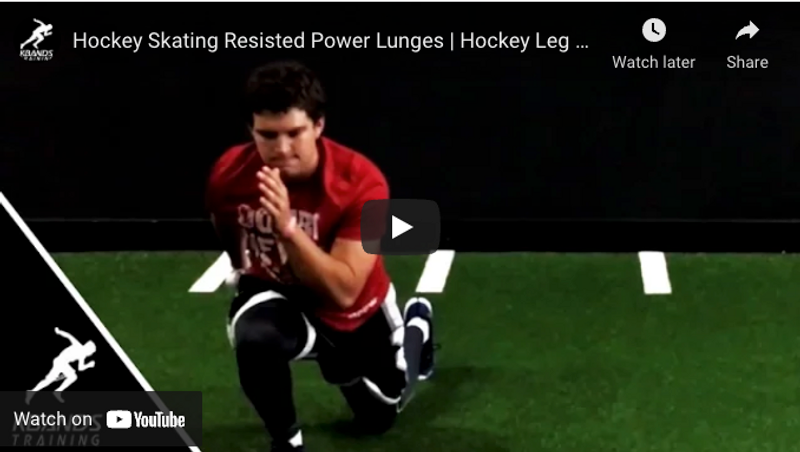Hockey Skating - Is It All About Speed?
The one ability that all hockey players would like to improve on would definitely be skating speed. While there are players who have been gifted with blazing speed, the good news is that this quality can be improved through training. Undoubtedly, skating speed is a key determinant in a hockey player’s success and the foremost feature of a speed skating competition. It goes without saying that practice and drills on the ice help develop skating speed, agility and balance, but training on dry land can supplement your on-ice practice, and help you strengthen your legs, and develop power in them so that you can skate faster on the ice. Today, in this post, we will try to understand what makes a player fast and discuss the most efficient ways to improve your skating speed so that you stay on top of your game.
Hockey Skating Training With Resisted Power Lunges
One of the most fundamental drills for hockey players working with Kbands is the speed skaters stationary lunge position. We are going to be working on a low position with our knees, slightly off the ground but very low on our hips. To begin, tie on those resistance bands a little above your knee and then stand with your feet next to each other. Your feet should be about hip width apart. Take a large step back with your left foot. Bend at the waist, keep back flat, chest up and head straight. Lower your body toward the ground until your right upper thigh is parallel to the floor and your right knee forms about a 90-degree angle. You can use the hand corresponding to the back foot in front of your chest for balance. This is the start position. It is important to keep your torso upright (perpendicular to the floor), hips lowered and shoulders straight down. Avoid rocking forward.
Remain in that stationary lunge for some time and then, push yourself up in a powerful jump. Accelerate and explode out of the stationary lunge position, bringing the back foot forward and landing into a lunge position on the other side. Focus on landing soft, using your hamstrings to pull your body down quickly, and exploding upward with your glutes. Complete 30 sec sets, back and forth, for about a minute break in between. Give your legs some rest before moving on to any other exercise.
Benefits Of Resisted Power Lunges
The first and foremost benefit of lunges is that they improve your stride. It is also an excellent exercise because it strengthens all of the major muscles of the lower body- glutes, hamstrings, and quads. It also gives you a host of other benefits like knee stability, foot and ankle strength, and power development. The downward phase of the stationary lunge described here involves strong eccentric contraction of the glutes, hams and quads as your body is slowly lowered, its weight almost entirely supported by the forward leg. The trailing leg isn't significantly involved, except for support and balance. The best part about lunges is that there are several variations you can make to the basic lunge movement. To make the drill more effective, we have put on a twist to the traditional lunge by adding a resistance band – it makes your leg muscles work more vigorously and leads to better muscle activation.
Explosive Hip Power Leads To Improved Speed And Performance
Developing strong hips is very important for a powerful skating stride. Remember that power comes from our legs and glides through our glutes, where as hip flexor help drive our knee forward. Therefore, strong and powerful inner thighs, thighs (quadriceps), hamstrings, and hip flexors allow for acceleration in skating, stopping, and change of direction.
In order to develop efficient and powerful strides, you must be able to set your hips back and bend at the knees, which is also called hip hinge in strength and conditioning parlance. Your hip mobility is critical in being able to apply forces throughout the full range of your optimal stride without compromising mechanical efficiency. Adequate hip mobility and strength will allow you to stay low and effectively skate while stopping, changing direction, and accelerating.
Stride Length and Frequency
Skating speed is decided by stride length and frequency. While stride frequency needs to be developed through on-ice practice, stride length can be improved with mobility and strength training. Since stride length is determined by the power produced by each stride, therefore, to increase the stride power, the strength must come from the hips and legs. The positions of the resisted power lunge discussed here mimic a lot of movements that we are going to be doing on the ice. It is for all these reasons that power lunges are still considered to be the bedrock of hockey skating training.
On a separate note, it is important to remember that hockey, like other sports, is played on one leg at a time. It is quite rare to see a hockey player pushing off with both legs at the same time. In fact, during a game, the players are required to balance on one foot hundreds of times. Every stride, crossover, and transition requires that they lift one leg and glide, rotate, or shift their weight while balancing on a thin piece of steel on the ice. For this reason, it is important to focus on skating drills that improve single leg balance. By doing this you are able to recruit more stabilizer muscles. The resisted power lunges discussed here will help you develop strength as well as balance because with only one leg on the ground at a time, balance is automatically going to come into play.

